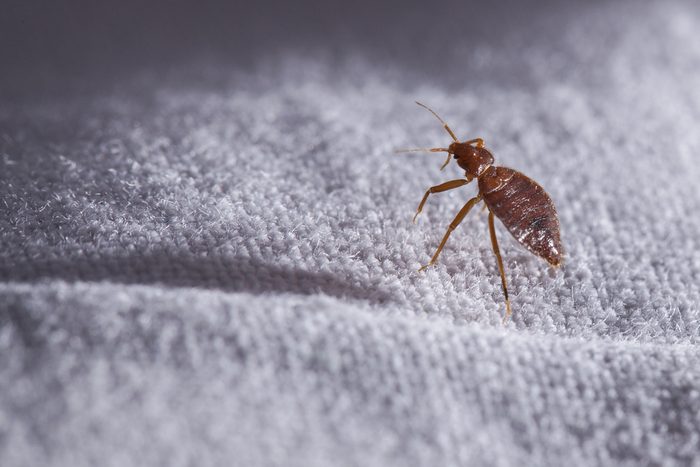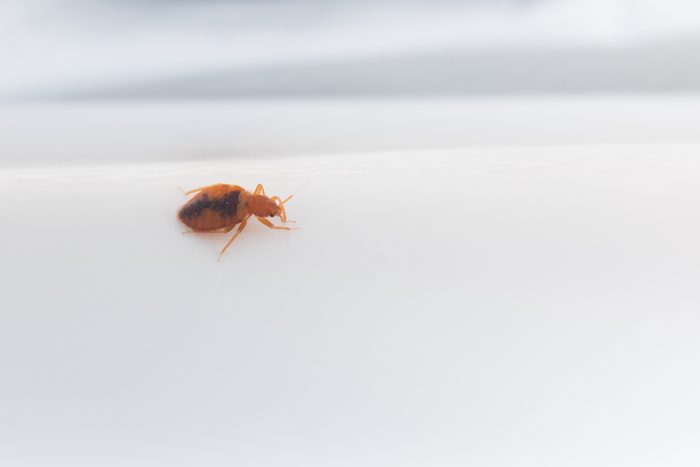
Bed bugs are microscopic
Just because you don’t catch bed bugs crawling around on your blankets doesn’t mean they’re too small to see with the naked eye. In fact, the reddish-brown pests are about the size of an apple seed, says Natalie Bungay, a technical officer with the British Pest Control Association. The real reason you normally can’t spot them is that they don’t want to be seen. “They’re quite evasive and good at hiding in cracks and crevices,” says Bungay. “Initially they might be hard to detect because they’re hiding away.”

Bed bugs spread disease
Even though bed bugs are parasites and can carry bacteria, they’ve never actually been known to spread disease, according to the Centers for Disease Control and Prevention. They do, however, give itchy bites and cause allergic reactions in people who are sensitive to their bite—not to mention the fact that they’re a general nuisance. “In terms of public health, the worst they do is psychological distress,” says Bungay.

Getting rid of bed bugs is an easy DIY
Despite the seemingly easy at-home bed bug solutions on the market, this is a job for the pros. Amateurs might not know how to use a steam treatment correctly, and attempting a heat treatment yourself is a fire hazard, says Sydney Crawley, PhD, public health entomologist at Scotts Miracle-Gro in Marysville, Ohio. Plus, bed bugs are resistant to some of the insecticides on the market, adds Bungay. “You can spend a lot of money trying to get rid of them yourself,” she says. Bite the bullet and call pest control for the quickest (and ultimately cheapest) solution. The pros use a combination of chemical, heat, and physical treatments that you won’t be able to pull off yourself. Here’s how to spot the warning signs you’re about to have a bed bug problem.

Bed bugs only come out at night
Bed bugs do generally stick to a nocturnal schedule; they like to bite when their hosts are sleeping so they can have an undisturbed meal, and most of the time that means coming out at night. But that doesn’t mean they’ll refuse to come out in the daylight. “Bed bugs adapt to the habits of their hosts, but if they need a blood meal, they can bite at any time,” says Crawley. If you work night shifts and have a bed bug problem, don’t be surprised if you still keep waking up with bite marks.

Anywhere with bed bugs must be grimy
Don’t judge a home by its bed bug status. “Whether we’re dirty or clean, they’re not too bothered,” says Bungay. “You can find them in the most expensive hotels in the world or the dirtiest slums. As long as there’s a human there, there can be bed bugs.” That said, shabbier hotels are less likely to catch an infestation early, and they might not have the money (or motivation) to call pest control as quickly as a five-star hotel would, she says. Find out more about where bed bugs come from.

Bed bugs can fly
Bed bugs can scurry about a meter per minute, which might be fast enough to make you think they’ve flown from place to place, says Crawley. But the only way these creepy crawlies can move is by, well, crawling. “The truth is that they have no wings, they cannot fly, and they also do not jump,” she says.

Bed bugs only live in beds
“Bed bug” is a bit of a misnomer. Even though they prefer to live where hosts sleep because it makes for easy nibbling, they can (and do) travel beyond the sheets. “Bed bugs are very flat and can fit in crevices as small as the width of a sheet of paper,” says Crawley. “So theoretically, you can find them nearly anywhere—but they especially love edges and tight spaces.” You should still do your most thorough check around the mattress and bed frame, she says, but it’s also possible to find them in curtains, nightstands, electrical outlet covers, and more. If you suspect bed bugs but haven’t found actual bugs yet, Crawley recommends using a product like Ortho Home Defense Bed Bug Trap to lure the pests out. Learn how to find (and get rid of) bed bugs in your car.

You can only get bed bugs from sleeping in an infested bed
You might associate bed bugs with hotels, but they can get in your home even if you haven’t been on a trip. “They’re pretty good hitchhikers,” says Bungay. She’s seen cases of one resident bringing back bed bugs, which crawl into a neighbor’s bedroom and cause problems in the apartment next door.

Bed bugs live on their hosts
Even though bed bugs feed on human blood, they don’t live on people, says Jody Gangloff-Kaufmann, PhD, Senior Extension Associate, Cornell College of Life Sciences and Agriculture in Babylon, New York. “Bed bugs hitchhike on people and their belongings. They can also move on their own through a house or apartment building.” They’ll travel on you but—they’re smart enough to know that if you find them, you’ll squash them. Instead of latching onto your skin or clothes, they’re more likely to cozy up in your luggage or purse. To avoid bed bugs at a hotel, inspect the luggage rack for bed bugs, then stash your suitcase there, suggests the Environmental Protection Agency. That way, your luggage and clothes are kept away from the carpet where bed bugs might be crawling around. Make sure you know these other 16 pest-control secrets bed bugs don’t want you to know.
